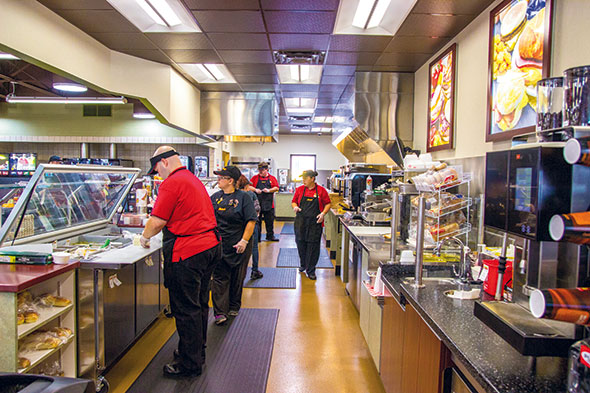As the lines between retail and foodservice continue to blur, specifying opportunities in the convenience-store segment may rise. Ryan Krebs, director of food service for Rutter’s, a 72-unit chain based in York, Pa., outlines 5 c-store-specific equipment and design needs.
1. Go vertical
Although the Rutter’s model is to go bigger, roughly 12,000 square feet (compared to 3,500 square feet for older models) when building new stores to better accommodate foodservice, the company still deals with the challenge of small spaces when renovating existing locations. In those cases, Krebs says his team looks to build up, rather than out.
“Width is a big deal for us, so we prefer to choose narrower pieces of equipment that we can double stack, rather than sit side-by-side,” Krebs says. The c-store chain invested in new, closed-unit, basket fryers with two small, side-by-side wells for multiple orders and menu items instead of a larger, single well fryer, as well as double-stacked microwaves and rapid-cook ovens.
2. Build up beverage
“Beverage is the key to continued growth in the convenience business for us,” says Krebs. In fact, packaged beverages account for 18.5 percent of c-stores’ revenue, according to data from the National Association of Convenience Stores (NACS)
Most recently, Rutter’s upgraded its barista-style, crew-served specialty espresso and coffee machines to ones with undercounter refrigerators and milk hookups in order to offer a wider variety of dairy and non-dairy milks. The c-store also rolled out a new line of adult slushies spiked with booze behind the counter for an additional crew-served item.
And, building in extra space for a wider variety of packaged, non-alcoholic beverages like flavored waters and energy drinks seem to be the key to the future. According to the NACS 2018 State of the Industry report, non-alcoholic packaged beverage sales at c-stores have risen 18.9 percent in the last year.
3. Maximize storage and shelving
Maximizing shelving is a key component to building in more space for storage. Seeking out shelving with adjustable heights, Krebs says, helps the chain make more efficient use of its storage.
Most standard shelving the chain uses comes in the form of a six-foot rack with four shelves, but adjusting those racks can be a challenge. Currently, even when loaded with standard, 20-ounce bottles, the shelves have 9 inches of remaining space, so being able to adjust for the height of these shelves would offer more storage space. “Every inch counts,” Krebs says.
4. Do more with displays
The sky is the limit when it comes to displays for c-stores, which routinely market for impulse purchases.
With the growth of fresh food in particular, “we’re seeing more customized, open-air display cases for better-for-you options catering to Millenial and Gen Z customers,” says Krebs, who expects to see more of these customers begin to use convenience stores as mini grocery stores in the near future. “As c-stores continue to offer more fresh grocery and better-for-you items, consumers will be able to trust them for their everyday grocery shopping needs. This used to be the norm decades ago before the big supermarkets came about, but we’re already seeing the growth of this mini-market trend among higher-end, boutique retailers in urban markets.
5. Set for seating
In-store dining represents another growth opportunity in c-stores, Krebs points out. “We’re starting to see convenience become more of a destination, in some cases with a food court-type feel, so in our newer layouts, we have carved out 30 seats within our stores for the dining area,” he says.
The new layout includes a mixture of single-seat, counter-seating against a wall or window as well as traditional tabletops and even highchairs for kids and outdoor seating in the form of stainless-steel tables and benches with canopies. “We are trying to capture everyone, from those looking to sit by themselves as well as families and larger groups,” Krebs says.
The convenience sector continues to grow at a rapid clip and foodservice continues to fuel this growth, Krebs says. There’s lots foodservice designers can learn from c-store design and equipment specification that can impact other industry segments that wrestle with similar issues such as speed of service, space constraints and more.






